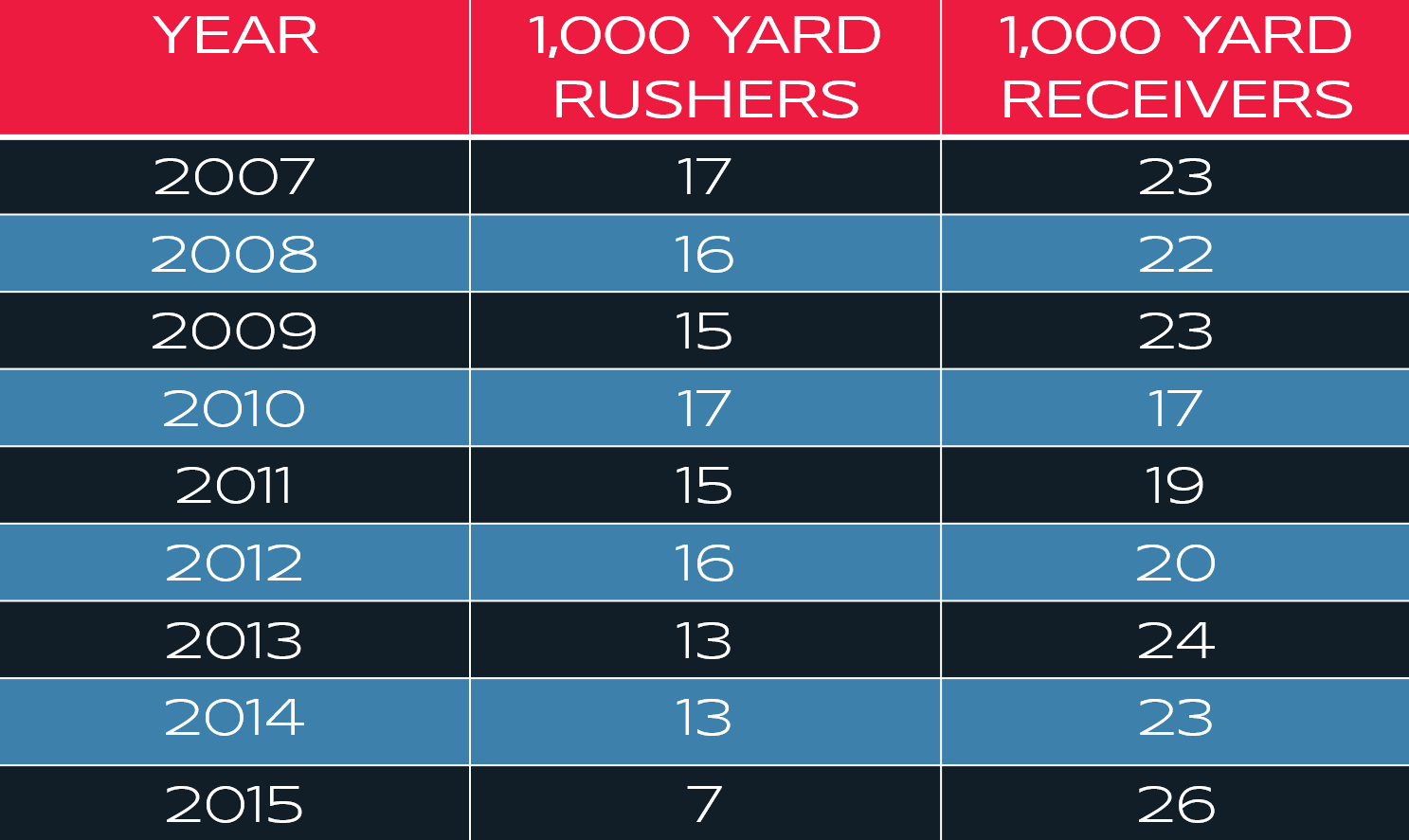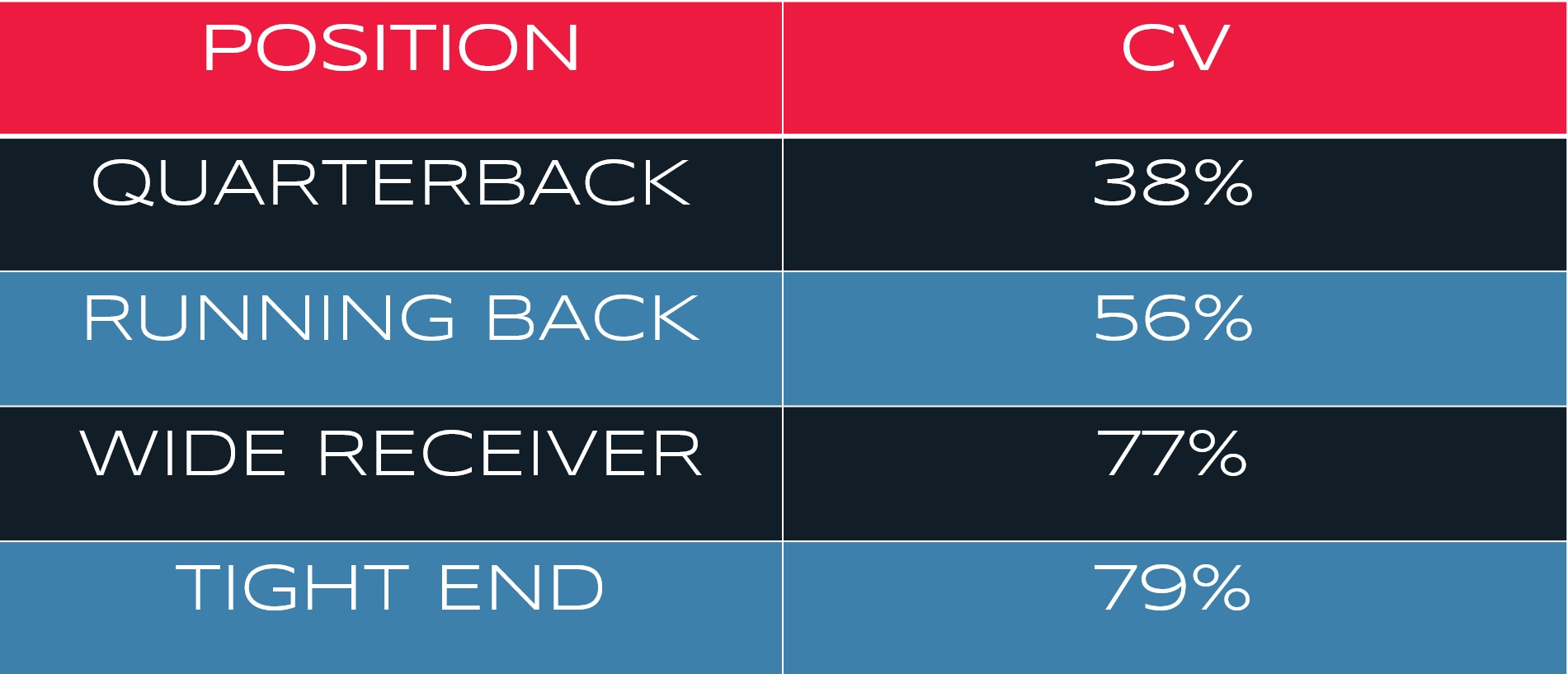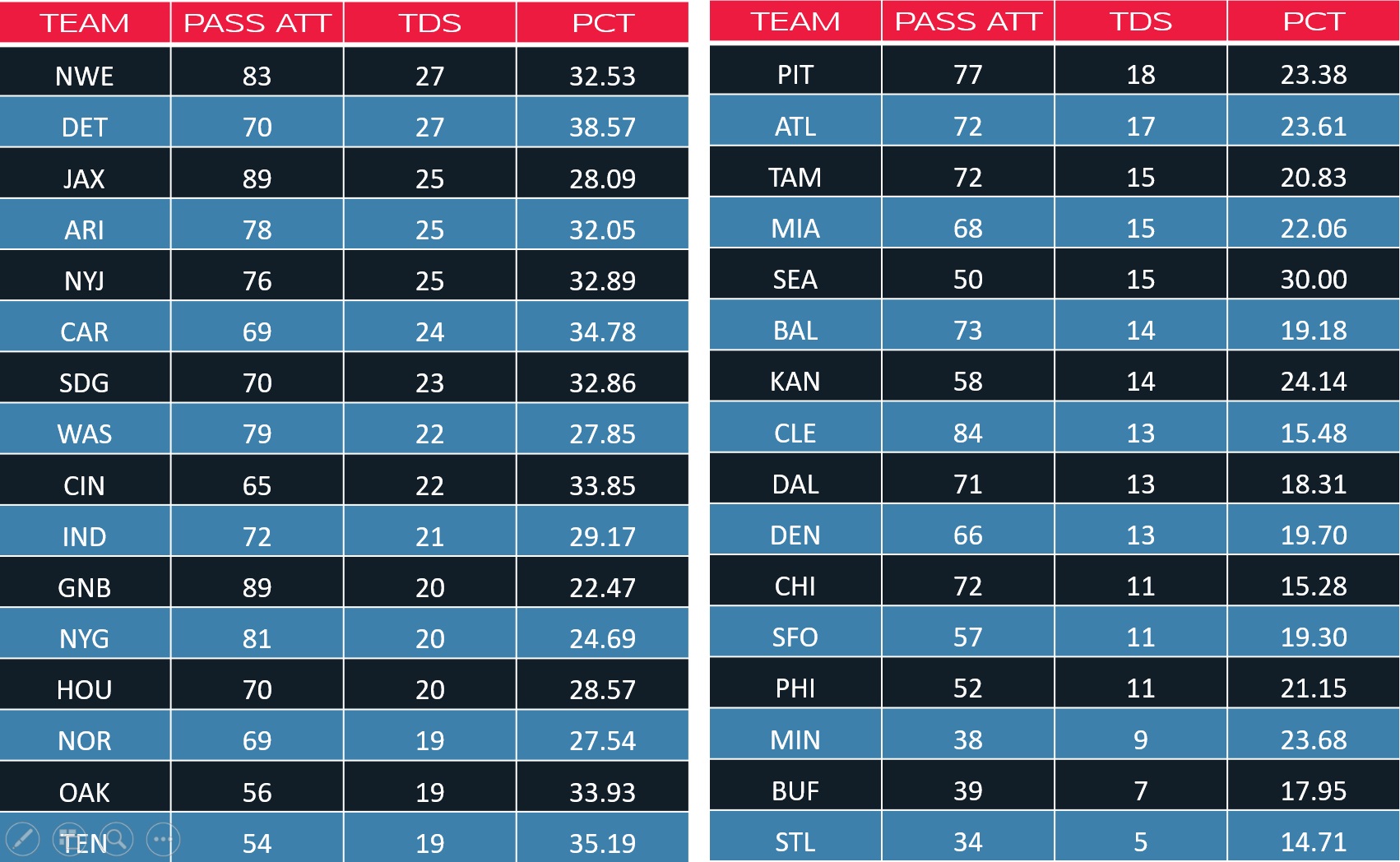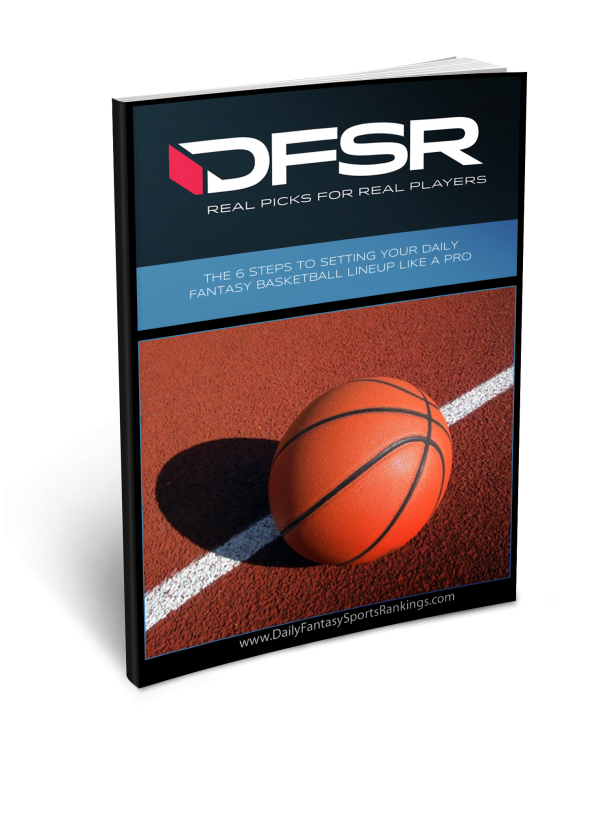featured Daily Fantasy Expert Advice
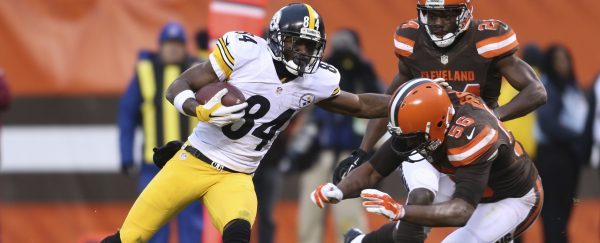
Finding good wide receiver plays when playing daily fantasy football on FanDuel and DraftKings
One of the most common themes in our considerable reader email each football season is, "how do I find a good QB/RB/WR/TE for double ups/big tournaments/heads up games." Which is to say, "how do I play daily fantasy football?" Well, that might be an oversimplification. But the feeling behind it is sincere - daily fantasy football is one of the most complex of all of the DFS contests because analyzing each position is an endeavor entirely unto itself. While there is some overlap, trying to figure out a good QB AND a good RB - to say nothing of a solid tight end or defense - requires analyzing all different kinds of data, from sportsbetting odds, to historical data, and more. This year, we're going to take selections out of our free NFL eBook and take an even deeper dive into how we go about picking players at each position for each kind of contest.
Today, we're going to look at Wide Receiver. We hope you enjoy!
In case you didn’t notice, we recently released our brand new NFL DFS suite of tools including full projections, optimal NFL lineups and Player Lab which includes filters to help you create NFL lineups for FanDuel and DraftKings. It’s a robust set of tools; well beyond anything we’ve ever had and something we feel will help our users *ahem* tackle the NFL season.
You can grab a free 2 WEEK trial to test out yourself.
FINDING GOOD DAILY FANTASY WIDE RECEIVERS
Football as a whole has changed dramatically in the last 10 years, and so has fantasy football in particular. The most notable changes have come offensively - what was once a run first league has moved in a decidedly pass-first direction, and old truisms of fantasy football have gone by the wayside in the process. In the last 4 years we've seen a dramatic shift in how skill position players are deplopyed, but the old truisms are still around. I was going to write this up in a paragraph, but Doug told me you guys like charts, so here's a chart.
Are you happy now, you visual learner you?
But seriously, are you seeing what I'm seeing here? From 2010-2012 we saw roughly the same number of 1,000 yard rushers and 1,000 yard receivers, even if there were slightly more receivers. As time progressed, however, most teams learned that they were physically killing their running backs by throwing them out there for 300+ carries per season, so fewer teams did so. They also realized that, while the plays have higher variance, passing plays tend to net more total yards in the aggregate than running plays do. As a result, only a handful of running backs have the opportunity to top the 1,000 yard plateau each season. While stalwarts like Adrian Peterson remain "safe," the real safety on a week to week basis can often come at the wide receiver position.
While, yes, wide receivers are more volatile on a week to week basis, their baseline performance is often higher, so paying the same amount for greater production even with higher variance is often the correct play. Understanding that wide receiver is incredibly deep AND possessing huge upside is going to be the key to crushing daily fantasy football this season, mark my words.
Wide Receivers and Relative “Safety”
Doug covered this in his running backs article, but last season wide receivers accounted for 11 of the 20 highest scoring fantasy totals last season. Granted, Antonio Brown was responsible for 4 of these, but the truth remains - you can generate a ton of upside out of the wide receiver position if you find the right guy in the right week.
But what about safety? Well, this is one of those cases where we need to think about the tier of receiver we're looking at, rather than just the position as a whole. In case you missed it, here's Doug's chart on positional CVs (coefficients of variation) from last season, which can give you a general idea of how each position performed as a whole in terms of safety.
But this chart doesn't paint the whole picture when it comes to evaluating positional safety. Last season, the top twenty running backs in terms of overall fantasy points had an average CV of .50 when they started. This suggests that the top running backs are “predictable” in the sense that they tend not to deviate wildly from their personal mean performance.
Interestingly, though, the top twenty WRs also fell in that safe range. When you hear the term "top 20 receiver," you might not realize that that includes guys like Brandin Cooks, or Jarvis Landry, or Mike Evans - guys that are not household names outside of the fantasy community. All this to say - now is probably the safest time in fantasy history to spend up at the wide receiver position, particularly if you go really upper tier with guys like Odell Beckham or Antonio Brown.
The difference between RB and WR though is when you get out of the top twenty. While running backs remain relatively predictable from week to week, wide receiver performance tends to vary greatly. While we'll rarely need to consider an RB outside of the top 20 in terms of raw points projection for a given week, we will often want to do so at wide receiver, particularly in big tournaments. Many big tournaments are decided by an off-brand WR3 moving into the WR2 slot and going off because the WR1 was being covered by an elite CB. The lesson here? You can get safety in the top 20 wide receivers, but we can also look for explosive upside outside the top 20 in a way we simply can not at the running back position.

New York Giants wide receiver Odell Beckham Jr. (13) makes a one-handed catch for a touchdown against Dallas Cowboys cornerback Brandon Carr (39) in the second quarter of an NFL football game, Sunday, Nov. 23, 2014, in East Rutherford, N.J. (AP Photo/Kathy Willens)
Targeting... Targets
It’s not exactly a secret nowadays, but the thing that tends to matter most when it comes to putting up big numbers as a wide receiver tends to be simply getting the ball thrown your way. In 2015 there was a .70 correlation between targets and fantasy points scored. Sure, this could be a little bit of a chicken/egg thing – it wouldn’t matter how many times Tom Brady threw the ball to me, I wouldn’t catch it because I’d never be open. So he also wouldn't throw it to me, leading to fewer targets. Circular. But QBs tend to know their WRs, and tend to get the ball toward the guys that they trust, who are usually the most skilled guys.
Now, some players are better at converting targets to catches than others (a player’s size matters here), but it can be tough to know who that will be in a given season, especially early on. That’s why I just look for guys who are targeted a lot, for both cash games and big tournaments, when making my decisions. Early in the season we'll see a lot of surprises in the target department, especially in circumstances where there have been big personnel shifts. Whom will Dak Prescott target in Dallas? How about Shaun Hill in Minnesota? RGIII in Cleveland? On those teams I'm going to look very carefully at who is getting a lot of looks. In many cases they'll turn those looks into catches and will be on most people's radar, but you'll be able to find hidden gems throughout the season when you notice a big target bump that didn't also line up with a big bump in receptions.
Red Zone: Let’s get Down and Close
While targets and receptions have become mostly a known commodity in the daily fantasy football world, I still see a lot of people improperly analyzing touchdown potential. Even on huge outfits, typically season long outfits, touchdown potential is something that's sort of universally spread upon all of the major players in a given offense. They assume that, in the long run, touch downs will tend to even out across the prominently featured skilled players, and ignore past performance.
While this is right to a certain extent - there's definitely such a thing as "running hot" in the touchdown department - it ignores all of the great tools we have at our disposal to accurately predict who will score the most touchdowns.
As former DFSR writer Chris Raybon astutely points out on 4for4,com, 66% of all touchdowns are scored in the red zone, and another 25% are scored on the opposing 49-20 yard lines. The biggest predictors of touch down scoring, then, are how often a team will get to the red zone, and what they will do when they get there. More good news for you! We have a chart showing exactly how often teams passed in the red zone last season, and you can feast your eyes upon it now.
The thing that jumped out to me immediately was the correlation between overall pass attempts and touchdowns (.66 - a very strong correlation). While certain teams were more successful than others at converting raw attempts to touch downs, the primary reason most teams scored more was simply that they tried more.
We can go deeper on a player level as the season goes along to figure out why certain players got the bulk of their team's targets down in the red zone (perhaps they were being covered by a tough cornerback one game, but had an easy match-up the following week), but generally speaking knowing a team's behavior in the red zone is the best way to spread the love on projecting touchdown scoring.
Do we care about guys who catch long balls? Sure. Inevitably we're going to have a few big tournaments this season that are decided by a guy catching a couple of 60 yard touchdown passes and scoring 25 fantasy points on 4 total targets. And I can't blame you for shooting the moon on those guys occasionally. But me? If I'm trying to catch lightning in a bottle, I'm going for a bigger bottle (more red zone targets) instead of going for... a bigger piece of lightning? Okay, that analogy fell apart quickly. The fact remains, the safest way to project touchdown performance (even if it isn't super safe) is just to look at the various team's ability to get in the red zone, and their habits when they get there.
Vegas, Defenses, and Game Scripts
While there's a lot of talk about opposing defenses when it comes to fantasy football analysis, season-long analysis tends to really fall short when it comes to analyzing arguably the most useful piece of data in projecting the script for a game - what Vegas thinks.
Why is Vegas better at this than, say, Mike Golic? We've said it a million times, but they have serious skin in the game. They don't want to make a "bold prediction" or seem clever, they just want to be right. If they're wrong, they lose millions of dollars. So they hire the smartest people to set the best lines possible.
While they can't be used in a vacuum (teams being better against the run or pass specifically absolutely matter here), they're incredibly useful for how the game will go more generally. Games with a high total are obviously going to be higher scoring on average, but not all high scoring games are created equally for the purposes of wide receivers.
The major reason? Teams change their behavior when either up or down by a large amount. When teams take big leads, they almost always scale back their passing attack. Some teams do that by moving in the direction of short passes (think the Patriots), and some teams just won't put the ball in the air at all (think the Vikings). Either way, your big name down-field threats will often see a dramatic decrease in targets the more their team takes the lead.
This is where analyzing the particular wide receiver profile can make such a big difference. A player like Julian Edelman will always be relevant in the Patriots' offense because of the types of routes he runs - possession routes that are meant to make short, reliable gains. A player like Mike Evans, on the other hand, who generates most of his value from long down-field routes, will lose a lot value.
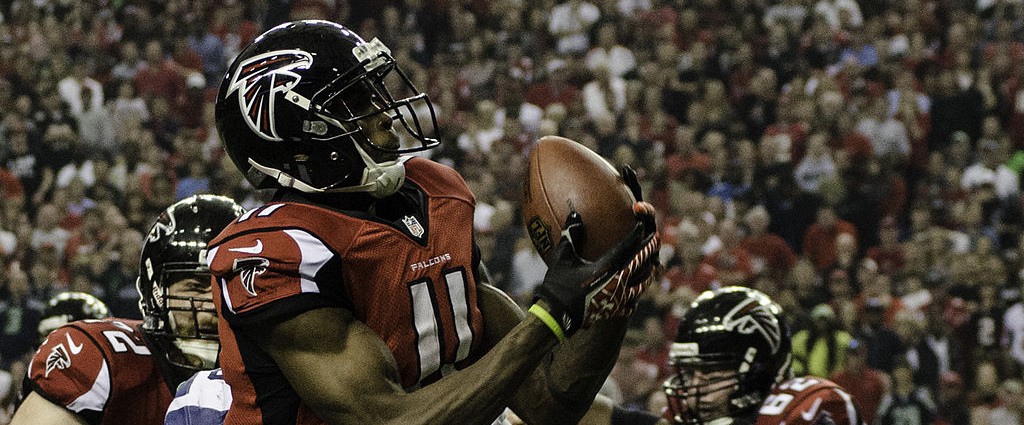
Interestingly, a lot of the guys who generate a lot of value by catching long passes tend to be playing from behind quite often. Evans' aforementioned Bucs qualify there, as well as guys like last year's break-out long ball man Allen Robinson. If players like these are in the unlikely scenario of being heavily favored, we can significantly downgrade their projection.
What about when a WR is on a team that's a big underdog? Well, this gets a little trickier. Yes, garbage time receiving yards have propelled many a daily fantasy football player to great heights, but again, we want to deploy a little bit of caution here. Elite talents like Robinson and Evans (or Fitzgerald in his prime) can put up big totals due to transcendent skill sets, but often times a team that's considerably ahead will take away the long ball to the degree that they can while opening up the short passing game with a prevent defense. While it's true that teams will pass way more when behind, individual player analyses matters quite a bit when determining who is actually going to get those garbage time targets. It tends to be top tier down-field threats and possession guys.
The cascading effects of shutdown cornerbacks
One of the hairier and least precise measurements we see from week to week are how elite cornerbacks effect given weeks. Now this is sort of tough to break down in a single paragraph - it's really an article unto itself - but there's often more that we can do here than meets the eye.
On a basic level, you'll often hear analysis like, "Josh Norman is going to be shadowing Antonio Brown here, so this should open up more looks for Martavis Bryant!" Unfortunately, this analysis only stops halfway. When faced with this problem, our team at DFSR actually broke down cornerback performance (as compared to league average) against all of the different wide receiver positions, and assigned ratings to how teams defend against given WR slots.
So instead of Josh Norman's effect on Antonio Brown, we instead would want to look at how Carolina had performed against WR2s. While these are related, the difference is subtle enough to make a huge difference. Take Seattle, for instance. Yes, Richard Sherman is a big name cornerback who will greatly depress the fantasy totals of opposing WR1s. But Seattle was no slouch against WR2s or WR3s, either. While it seems obvious, we care way more about who a given WR is paired up against, as opposed to who his teammates are paired up against.
All of that said, we have found that the big name shut down CBs have a profound impact on how targets are assigned. Guys like Josh Norman will, in many cases, stop opposing QBs from targeting the best WR on their team at all. This doesn't usually stop that team from passing, though, and all of a sudden there are a ton of other targets to go around. I hate to sound like a shill here, but I believe our lineup optimizer and our new Player Lab does a much better job of this than any individual can using anecdotes from ESPN.
In closing
There's a ton to consider when it comes to projecting daily fantasy wide receivers, and while this article is a good start, there's a lot that we could have gotten into that we didn't this time around. We'll keep putting out updates and primers throughout the season, so be sure to tune in for more analysis as we go!
Feeling like this is a lot to process? It is. It's why we're offering a free 2 week trial to our brand new player lab to start the season.
You can grab a free 2 WEEK trial to test out yourself.
image sources
- Cowboys Giants Football: (AP Photo/Kathy Willens)
- 1024px-Julio_Jones_catching_a_pass: By Georgia National Guard (Flickr: Playoff Pass) [CC BY 2.0], via Wikimedia Commons
- Antonio Brown, Karlos Dansby: (AP Photo/Ron Schwane)

 Free Player Lab Trial
Free Player Lab Trial